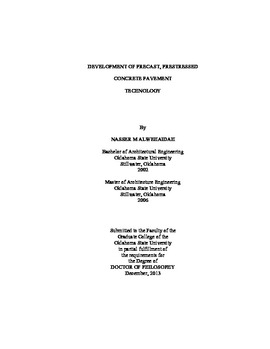| dc.contributor.advisor | Russell, Bruce W. | |
| dc.contributor.author | Alwehaidah, Nasser M. | |
| dc.date.accessioned | 2015-06-17T20:04:34Z | |
| dc.date.available | 2015-06-17T20:04:34Z | |
| dc.date.issued | 2013-12 | |
| dc.identifier.uri | https://hdl.handle.net/11244/14695 | |
| dc.description.abstract | Precast prestressed concrete pavement (PPCP) can provide many advantages over other pavement alternatives whether asphalt or concrete. The possible advantages are thinner pavement, faster construction, increased durability, better quality concrete, efficient use of materials, better economy by repetition, and large reductions in user costs. However, there are some disadvantages associated with precast post-tensioned concrete pavement construction including the need for more specialized and currently non-standard construction equipment, a sometimes overall decrease in ride quality, higher costs for small projects, relatively complex construction when compared to traditional rigid and flexible pavement, and different or undefined standard design procedure. Even so two of the primary benefits, reduced user costs through more rapid construction and thinner pavement, are particularly compelling in rehabilitation of urban pavements and increasing the clearance for bridges underpasses. | |
| dc.description.abstract | The general objectives of this research are to (1) investigate and analyze the current state- of-the-art, (2) examine and possibly improve the current design features, (3) perform structural analysis to evaluate pavement performance and limitations, (4) conduct laboratory tests to examine and verify proposed improvements and analysis results, (5) investigate means to make precast pavement more durable and economical. | |
| dc.description.abstract | The general objectives of this research will be achieved by using design innovations such as granular base material to reduce the overall thickness and panels with grout voids on the bottom to achieve maximum contact with the granular base. Experimental research will investigate precast prestressed concrete pavement response to static loads. Analytical research work will investigate pavement response to the effects of non-uniform subgrade support conditions and dynamic loadings. From work on dynamic loadings it is expected to develop ideas for minimum pavement thicknesses and the influence of subgrade reaction on dynamic response. | |
| dc.format | application/pdf | |
| dc.language | en_US | |
| dc.rights | Copyright is held by the author who has granted the Oklahoma State University Library the non-exclusive right to share this material in its institutional repository. Contact Digital Library Services at lib-dls@okstate.edu or 405-744-9161 for the permission policy on the use, reproduction or distribution of this material. | |
| dc.title | Development of precast, prestressed concrete pavement technology | |
| dc.contributor.committeeMember | Cross, Stephen A. | |
| dc.contributor.committeeMember | Ley, Tyler | |
| dc.contributor.committeeMember | Good, J. K. | |
| osu.filename | Alwehaidah_okstate_0664D_13059.pdf | |
| osu.accesstype | Open Access | |
| dc.type.genre | Dissertation | |
| dc.type.material | Text | |
| dc.subject.keywords | concrete | |
| dc.subject.keywords | pavement | |
| dc.subject.keywords | post-tension | |
| dc.subject.keywords | ppcp | |
| dc.subject.keywords | precast | |
| dc.subject.keywords | prestressed | |
| thesis.degree.discipline | Civil Engineering | |
| thesis.degree.grantor | Oklahoma State University | |
